Tosca
Giacomo Puccini
Libretto by Luigi Illica & Giuseppe Giacosa
Opera San José
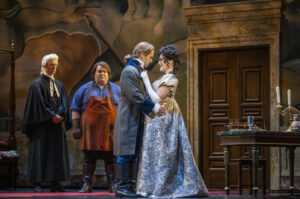
Immensely impressive, profoundly passionate, and musically masterful from first notes to closing plunge off the parapet describe Opera San José’s triumphant production of Giacomo Puccini’s timelessly popular Tosca. Within the setting of San José’s beautifully majestic California Theatre, the 1900-premiering opera reigns supreme with its familiar arias that soar; its glorious orchestration that awakens the soul; and its storyline full of intrigue, romance, and great contrast of the heroic and the diabolical. From the powerfully stunning voices of the three, key principals to the angelically sweet soprano of a shepherd boy, Opera San José has assembled a cast that to a person never falters in delivering a memorable and moving Tosca.
The tightness of the timeline of Tosca – with all the action occurring in less than twenty-four hours – as well as the historical context of Napoleon’s June 17, 1800, approach toward Rome only enhance the stakes and the tension of the Luigi Illica and Giuseppe Giacosa’s libretto. The storyline is brimming with torture, murder, and suicide as well as romantic flirting, jealousies, and fruition. The difference between life and death or between love gained and love lost centers time and again on decisions that must be made on incomplete information. The frailty of human existence in a time of national upheaval rings as true today as it did over two centuries ago in light of the invasions and conflicts currently disrupting thousands of lives around the globe – everyday people much like Puccini’s singer Tosca, painter Cavaradossi, or patriot prisoner Angelotti.
When the former counsel of Rome and now escaping political prisoner, Angelotti (baritone Robert Balonek), arrives at a chapel to look for a disguise left by his sister, he is discovered by his friend, Cavaradossi, who is painting a Madonna whose face resembles Angelotti’s pious sister whom the painter has previously observed praying. Cavaradossi hides his friend from the pursuing police, sealing his own fate without knowing it as he sings, “If it cost my life, I will save you.”
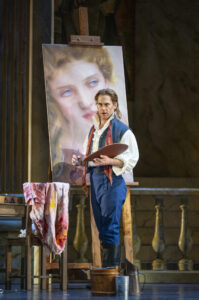
Soon to enter is the enticingly attired Tosca to catch a moment and maybe a kiss from her beloved artist. Upon hearing another voice as she arrives, she suspects Cavaradossi of unfaithfulness, especially when seeing his Madonna of blue eyes is not she of eyes much darker. What follows is our first real chance to revel in the voices of Maria Natale and Adrian Kramer, soprano and tenor extraordinaire, respectively. Her bout of accusations and his pleas of innocence are followed by their declarations of true love, with each voice immediately striking in its clarity and expression.
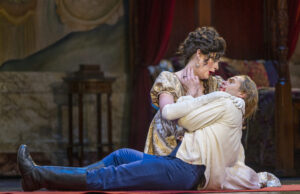
Tosca describes (as the Italian libretto is translated into English) a scene where “the night murmurs its thousand loves,” her notes painting in flowing, effusive patterns even more vividly than her words how she “burns with a mad love” for Cavaradossi. His tenor responses of resplendent notes pour forth his own passion for her. In a departing duet, their voices mingle and blend to embrace musically even as their bodies mold into one. From this, our first introduction of the two together to their final, fateful embrace only a few hours later, there is a palpable, pulsating passion in the love felt and expressed between this pair of lovers – passion so visceral that its electricity seeps into the audience to provide us with responding tingling and quickness of our own breaths.
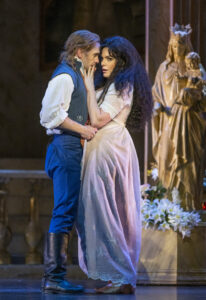
As Tosca, Maria Natale will continue to thrill us both with her vocal and her acting prowess. Her ability lightly and effortlessly to ascend the musical scale and then to sustain seemingly forever a note so soft yet so high is matched by her equally astounding power that can blast her horror or her fear in notes of sheer, soprano clarity, proving her ability to excel in a full range of masterfully controlled volume.
Similarly, Adrian Kramer’s Cavaradossi provides bountiful reasons to extol his performance. In his final aria, he remembers the scent of perfume and the feel of kisses of his Tosca, singing notes that throb as they beautifully project his fervorous affection. His Cavaradossi brings to mind through his accomplished renditions of Cavaradossi’s arias other great tenors preceding him in this iconic role; but Adrian Kramer finds his own, unique interpretations to wow us as an audience, not only in his vocals, but also in his abilities as a first-rate actor.
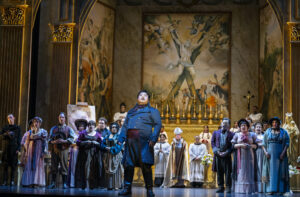
Not to be overlooked as equally notable is the sinisterly stellar performance of Kidon Choi as Scarpia, in some ways the devil incarnate whose evil, slithering manner and his booming bass voice repeatedly come close to being showstoppers. When the Chief of Police first enters the chapel just as services and Te Deum are about to begin, his deliciously deep chords trumpet his arrival as he scolds the assembled whom the pompously pious Scarpia believes are being too jovial and chatty. As he struts around, his walk is that of a proud peacock in full feather. Those first, reverberating notes are a preview of a voice that later seethes in a rich, but disturbing sung plot how he plans to force Tosca into his bed as a means supposedly to save the life of Cavaradossi, whom Scarpia knows has helped the traitor Angelotti to escape. His Scarpia often leans into his sung phrases with such power and persistence of tone to send shudders down one’s spine, particularly as he describes what will happen to Tosca’s lover if she does not acquiesce to his demands.
The high drama of the story works so well because Puccini keeps these three and their fates always in our primary focus. Other fine singers, a well-voiced Chorus of twenty-four, and a charming Children’s Chorus of ten also appear on Opera San José’s stage; but it is these three we walk away with their extraordinary performances seared into our memories. But tremendous kudos go also to Conductor Joseph Marcheso and the Opera’s orchestra for a resounding, often rapturous rendering of Puccini’s famous score. I sometimes found myself turning my focus from the stage to relish the orchestra’s richly rewarding score. On another evening, I would have been happy just to listen to the orchestra’s Tosca sans any actors/singers.
One of the other reasons this particular production is so captivating goes beyond the music itself and is due to the talents of the creative team. The grand interior of the Roman chapel with its massive paintings, layered arches, and statue of the Madonna and Child is quite awe-inspiring as designed by Steven C. Kemp, with the residence of Scarpia and the roof setting of Hadrian’s mausoleum-turned-prison, Castel, equally monumental in design and effect.
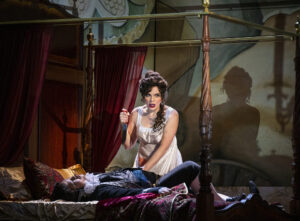
The lighting designed by Lee Fiskness takes its own spot as a starring role throughout the evening. Through is expansiveness, at one point the stately California Theatre becomes part of the chapel as Te Deum is sung, with the arch of the proscenium becoming a heavenly lit halo above the services below. Later, giant, plunging shadows on a walled corner become a second stage where the struggle between Tosca and Scarpia play out furiously. And as one anticipates in every Tosca, the too-fast approaching dawn of the final scene that will mean life’s end for both lovers is ever-so-slowly and quite splendidly recreated by a sky’s multi-colored shift from night’s dark to the day’s full rays of sun. Full applause for a lighting scheme that is stunning throughout.
As a first-time attendee to Opera San José, I can only assert that this will be the first of many, future visits. While a certain opera company to the north often receives the Bay Area’s prime attention, more eyes should also turn southward to find a company that is also producing opera on a scale of grandness and of excellence worthy of much attention.
Rating: 5 E
Tosca continues in performance by Opera San José Sunday, April 23; Friday, April 28; and Sunday, April 30, 2023, at the California Theatre, 345 South 1st, San José, CA. Tickets are available online at www.operasj.org and by phone Monday – Friday, 9 a.m. – 5 p.m. at 408-437-4450.
Photo Credits: David Allen
